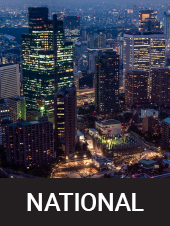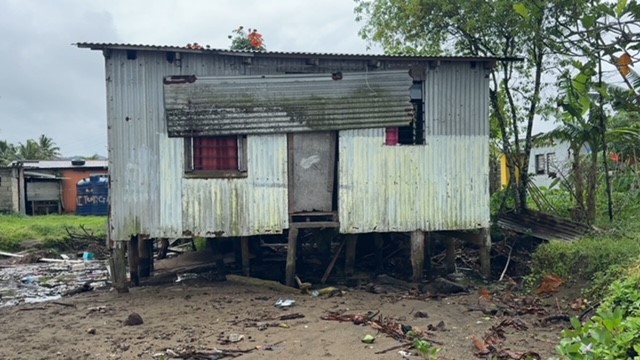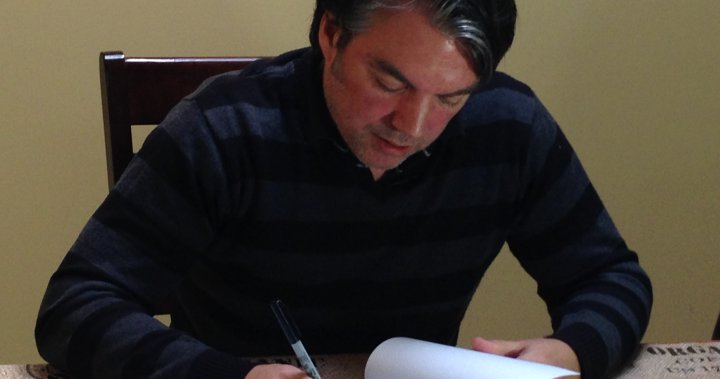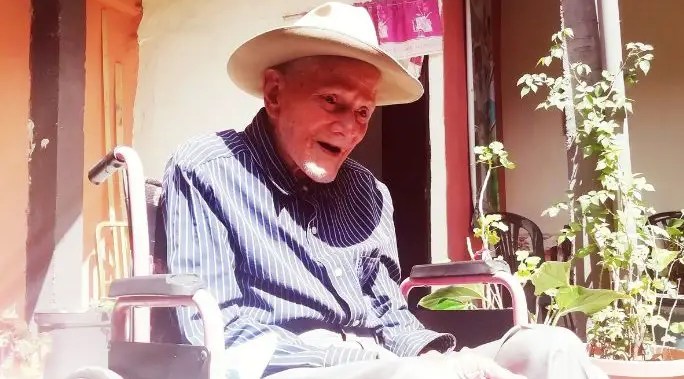Developing countries like Fiji are some of the most affected by climate change — and least able to afford the consequences.
With 90 per cent of Pacific Islanders living within five kilometres of the coast, the impacts of flooding, coastal erosion and rising sea levels are an everyday reality.
In Nasilai — a village within Tailevu province on Fiji’s largest island — 300 people live in just over 40 houses along the water. It’s among the many Pacific Island communities that have been dealing with the impacts of climate change, including rising sea levels.
“If the mangroves were not here, all of this place would wash away,” said Nasilai village leader Savenaca Delai.

Nasilai Village leader Savenaca Delai sits on the sea wall built by his great grandfather to prevent flooding.
Megan King/Global News
A line of mangrove trees hugs the coastline, blocking bigger waves from the heart of the village. Still, Delai is not confident that the trees would be enough against a larger storm.
“It’s dangerous,” he said. “If one tsunami comes over our place, the whole village will wash away — nothing else. Nothing will be left.”
Delai’s great-grandfather built a small sea wall out of cement and coral years ago to protect the village from erosion, but it’s overdue for an upgrade.
In conversations with the Fijian government, Delai has learned that their sea wall request is in this year’s budget, but no timeline has been given and that funding could be impacted by natural disasters.
In the meantime, efforts to plant more mangrove trees are in the works with the help of non-profit organizations and government funding — although fear remains around what impact future storms may have on the village’s safety and security.
“Climate change is real. It’s real and it’s happening right now as we speak. The sea is definitely rising,” said Delai’s nephew Kelebi “Gabby” Tuitavuki.

Kelebi “Gabby” Tuitavuki explains the changes he has seen to his home village of Nasilai over the decades, as a result of rising sea levels.
Megan King/Global News
Tuitavuki has a house in the village that he grew up in. He now only comes back on weekends and holidays as he works in Fiji’s capital of Suva.
He had always heard about the impacts of climate change, but didn’t take it seriously until it came to his shore
“Where my village is, my house is next to the beach. When I was young, I could walk 10 metres before I reached the sea level, but now as I’m getting older, I can just walk two or three metres and reach the sea level.”
His home stands on cement blocks to try to prevent flooding.
Some days water levels can rise into the village, damaging houses and washing pieces of land out to sea.

For Delai, climate preparedness efforts are necessary — as leaving isn’t an option.

Get daily National news
Get the day’s top news, political, economic, and current affairs headlines, delivered to your inbox once a day.
“We’ve got no other place to go. We haven’t got any other place around, only this place,” Delai said. “So, for us in the village, we stay in the village…pray to God to help us, protect our coral coast from rising sea levels.”
As the impacts of climate change affect community safety, livelihood and food security across the many Pacific Islands, preparedness efforts are being taken.
According to Fiji’s Ministry of Environment and Climate Change Permanent Secretary Dr. Sivendra Michael, they don’t have the luxury of waiting around for something to be done.
“It’s compromising our livelihoods, it’s scaling up the levels of economic losses in damage,” he said. “The climate crisis is real, and the realities that are faced by frontline communities such as those in Fiji and across the Pacific and other seas are things that are not stories. They are lived realities of people and communities on a day-to-day basis.”

Sandbags sit ready for use at the shoreline of Levuka, Fiji’s first capital.
Megan King/Global News
Grassroots efforts towards climate preparedness
A white pickup truck was filled with hundreds of tree seedlings, as dozens of villagers in Serua Province came together for a day of planting.
These Fijians are working to protect their community from mudslides and flooding — as seawater intrusion and land degradation in the area becomes exacerbated by climate change.
Just a few months ago, the Vunaniu Village saw flooding that impacted all its villagers — many of whom are elderly, disabled or young children.
A sudden storm with little chance for villagers to prepare ahead of time, the community rushed to evacuate.
“All of our houses are underwater. This one is my house and that one too is underwater,” village elder Atunaisa Mocelutu pointed out.
Homes that were closest to the waterfront are now unlivable, with pieces of the coastline also being lost to erosion.

Vunaniu Vilage leader Keni Bukarau (middle) helps plant one of the first seedlings as part of this community-led sustainable solution.
Megan King/Global News
Now, community-led projects are hoping to build community resilience for when the next disaster strikes.
“We have to replant the trees again so they can help our forest,” said village leader Keni Bukarau. “Help with landslides and everything during heavy rains and climate change.”
The village is participating in a first-of-its-kind ‘Resilient Community Project’ being funded by the Locally Managed Marine Area Network (LMMA) alongside the Canada Fund for Local Initiatives.
The project will fund 3,000 mangroves being planted, fruit trees and training programs for locals to understand how to lead sustainable solutions.

Members of Vunaniu Village take part in community resilience projects funded by LMMA alongside the Canadian government.
Megan King/Global News
Disaster risk reduction projects
North of Fiji’s mainland, similar projects are in the works.
Nacula District representative Lavenia Naivalu can be found motoring around in her speedboat, going from island to island checking on her community.

Nacula District representative Lavenia Naivalu is working to make her community a “greener pasture” that young villagers will want to stay and call home.
Megan King/Global News
She is working to see more Disaster Risk Reduction (DRR) projects take root in the Yasawa Islands.
“I go out to my communities and you see that the graveyards are washing out and we had to forcefully relocate families because water is coming under their houses,” said Naivalu. “So, it’s something that we are dealing with in our everyday life.”
Her island has seen a lot of changes over the decades, including many communities either already relocated or preparing to relocate — a reality that hurts her to see happening.
“We are not the ones who are dumping nuclear waste, we are not the ones who are building the tallest buildings. I mean, here we are, victims of this situation. Victims of climate change, victims of their wrongdoings — big people’s wrongdoings. Why do we deserve it? And is there anyone who is going to listen to us?”
Naivalu wants countries contributing to climate change to fund resiliency projects in the Pacific, and ensure that funding gets directly to the communities in need.
Calls for Canada to take climate action
This year’s Climate Change Performance Index (CCPI) ranks Canada 62nd out of 67 countries for climate mitigation performance, making no progress from last year.
“Humanity is at risk, the planet is at risk, and so, we definitely need to make these big changes,” said WWF South Pacific Policy Coordinator Alfred Ralifo. “I don’t see any other options or any other solutions.”
Ralifo sees a huge disconnect between what is being agreed to at a global level and the realities of efforts on the ground.
“Every year our communities — especially the grassroot communities and those most vulnerable — are heavily impacted by the impacts of climate change,” said Ralifo.
“Yet, the decisions agreed at the global level are not translating fast enough and it’s not reaching the communities on the ground fast enough to be able to address the impacts of climate change and to build resilience.”
Dr. Michael thinks it is high time that countries that have not experienced these impacts themselves visit and learn.
“Witness it through their own eyes and try to comprehend the large levels of losses and damages that our own economies are absorbing at the cost of large polluting countries,” he said.
Those losses include the homes of many, as relocations becomes a reality.

A young Vunaniu village resident watches on as climate preparedness efforts are taken to reduce flooding impacts to his home.
Megan King/Global News
Six communities in Fiji have been relocated since 2012, with 17 priority communities in line to join them.
On Canada’s East Coast, bigger and more frequent storms have revitalized conversions around climate impacts. Fiji acting as a lookahead to what may result from coastal erosion and flooding.
Ecology Action Centre Coastal Adaptation Coordinator Nicholas Winkler lives and works in Halifax, but understands the challenges facing Fiji.
Winkler grew up in Grenada — a Caribbean country also facing climate-related challenges.
“It’s really the countries who are least able to adapt, who least have the means, who are in low-lying countries or in paths of storms. They’re the ones who are bearing the costs of that,” said Winkler.
“There is a sense of injustice, particularly in developing countries. And that’s where the questions of sort of climate adaptation funds come in.”
In 2021, Canada increased its commitment to International Climate Finance by pledging $5.3 billion over five years.
Still, the region around Fiji only gets about one per cent of international climate contributions — even though Pacific nations are among the most vulnerable to climate change impacts.
“There’s a moral imperative,” said Dr. Michal. “To save the lives of those front-line communities, they need to do more.”



